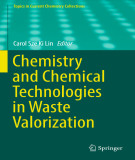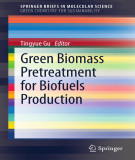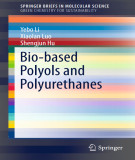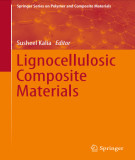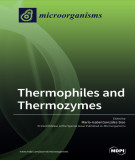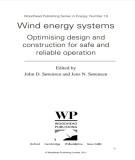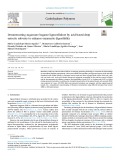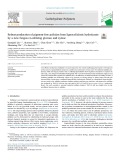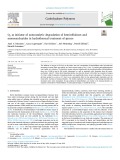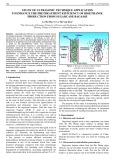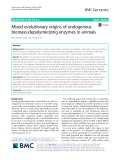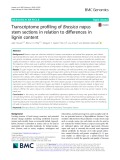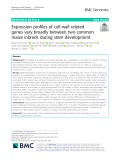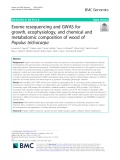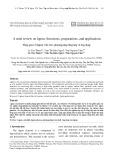
Lignocellulosic biomass
-
Ebook "Chemistry and chemical technologies in waste valorization" provides readers with contents including: sonocatalysis - a potential sustainable pathway for the valorization of lignocellulosic biomass and derivatives; waste printed circuit board (PCB) recycling techniques; chemical valorization of cashew nut shell waste; valorisation of biowastes for the production of green materials using chemical methods; valorization of proteins from Co- and By-products from the fish and meat industry;...
 292p
292p  tracanhphuonghoa1007
tracanhphuonghoa1007
 22-04-2024
22-04-2024
 2
2
 2
2
 Download
Download
-
Ebook "Green biomass pretreatment for biofuels production" emphasises the tactical mobile and on-farm scales applications that use green pretreatments and processing technologies without the need of on-site waste treatment. Because of the varieties of different biomasses, no single pretreatment is expected to be the universal choice. Some of the pretreatment methods present niche applications are also discussed.
 158p
158p  nhanphanguyet
nhanphanguyet
 28-01-2024
28-01-2024
 5
5
 2
2
 Download
Download
-
Ebook "Advances in bioprocess technology" provides an extensive overview of the latest research in environmentally benign integrated bioprocess technology. The cutting edge bioprocess technologies highlighted in the book include bioenergy from lignocellulose materials, biomass gasification, ethanol, butanol, biodiesel from agro waste, enzymatic bioprocess technology, food fermentation with starter cultures, and intellectual property rights for bioprocesses.
 529p
529p  nhanphanguyet
nhanphanguyet
 28-01-2024
28-01-2024
 5
5
 2
2
 Download
Download
-
In ebook "Bio-based polyols and polyurethanes" the most recent advances in the production of polyols and polyurethanes from renewable resources, mainly vegetable oils, lignocellulosic biomass, starch, and protein. The typical processes for the production of polyols from each of the above mentioned feedstocks are introduced and the properties of the resultant polyols and polyurethanes are also discussed.
 86p
86p  nhanphanguyet
nhanphanguyet
 28-01-2024
28-01-2024
 3
3
 2
2
 Download
Download
-
Ebook "Lignocellulosic composite materials" comprehensively summarizes important aspects of research in the active field of lignocellulosic (polymer) composites, including polymer materials from or containing cellulose, hemicellulose and lignin. It describes how these materials can be produced from forest products and natural fibers from sources such as jute, flax, sisal, and many more, and even from agricultural residues (like wheat straw, corn stover, or sugarcane bagasse).
 451p
451p  lamquandat
lamquandat
 28-12-2023
28-12-2023
 5
5
 2
2
 Download
Download
-
Part 1 of ebook "Thermophiles and thermozymes" provides readers with content including: editorial for the special issue - thermophiles and thermozymes; into the thermus mobilome - presence, diversity and recent activities of insertion sequences across thermus spp.; genome analysis of vallitalea guaymasensis strain L81 isolated from a deep-sea hydrothermal vent system; molecular tunnels in enzymes and thermophily - a case study on the relationship to growth temperature;...
 95p
95p  lytamnguyet
lytamnguyet
 04-08-2023
04-08-2023
 7
7
 3
3
 Download
Download
-
Part 1 of ebook "Wind energy systems: Optimising design and construction for safe and reliable operation" provides readers with content including: generating power at high efficiency - combined cycle technology for sustainable energy production; advanced separation techniques for nuclear fuel reprocessing and radioactive waste treatment; bioalcohol production: Biochemical conversion of lignocellulosic biomass;...
 310p
310p  lytamnguyet
lytamnguyet
 04-08-2023
04-08-2023
 7
7
 3
3
 Download
Download
-
Biorefinery with deep eutectic solvent (DES) is an emerging processing technology to overcome the shortcomings of conventional biomass pretreatments. This work evaluates the biorefinery of sugarcane bagasse (SCB) with DES formulated with choline chloride as hydrogen bond acceptor and three hydrogen bond donors: lactic acid, citric acid, and acetic acid.
 8p
8p  vihermione
vihermione
 30-12-2022
30-12-2022
 9
9
 2
2
 Download
Download
-
Cost-efficient production of pullulan is of great importance but remains challenging due largely to the high-cost carbon sources. Lignocellulosic biomass is considered an alternative carbon source for industrial pullulan production, while new fungus producers that co-utilizing lignocellulose-derived glucose and xylose are required.
 10p
10p  viginny
viginny
 30-12-2022
30-12-2022
 6
6
 2
2
 Download
Download
-
The influence of oxygen (0–50 bar) on the molar mass and composition of hemicelluloses after hydrothermal treatment of spruce chips was studied in a batch reactor setup at 130 ◦C–160 ◦C. Purified galactoglucomannan was studied as a reference.
 10p
10p  viginny
viginny
 30-12-2022
30-12-2022
 14
14
 2
2
 Download
Download
-
Nanocellulose is a unique and promising natural nanomaterial and has gained significant attention due to its applications in several important areas. Thus, researchers are continuously looking for the most efficient, sustainable, economically viable, and environmentally friendly production technologies to fulfil its growing demand.
 20p
20p  viginny
viginny
 30-12-2022
30-12-2022
 11
11
 2
2
 Download
Download
-
Lignocellulosic biomass is a potential material source for ethanol production. Particularly, the sugarcane bagasse (SCB) coming from the sugar waste of the refinery is very rich in lignocellulose that can be biochemically transformed into ethanol. However, its recalcitrant structure necessitates a pretreatment step to break up the lignocellulosic matrix, thus improving the accessibility of hydrolytic enzymes to carbohydrates for sugar production.
 4p
4p  vilexus
vilexus
 05-10-2022
05-10-2022
 20
20
 2
2
 Download
Download
-
Trichoderma harzianum is used in biotechnology applications due to its ability to produce powerful enzymes for the conversion of lignocellulosic substrates into soluble sugars. Active enzymes involved in carbohydrate metabolism are defined as carbohydrate-active enzymes (CAZymes), and the most abundant family in the CAZy database is the glycoside hydrolases. The enzymes of this family play a fundamental role in the decomposition of plant biomass.
 12p
12p  vilarryellison
vilarryellison
 29-10-2021
29-10-2021
 9
9
 1
1
 Download
Download
-
Animals are thought to achieve lignocellulose digestion via symbiotic associations with gut microbes; this view leads to significant focus on bacteria and fungi for lignocellulolytic systems. The presence of biomass conversion systems hardwired into animal genomes has not yet been unequivocally demonstrated.
 10p
10p  vibeauty
vibeauty
 23-10-2021
23-10-2021
 12
12
 1
1
 Download
Download
-
Sugarcane bagasse has been proposed as a lignocellulosic residue for second-generation ethanol (2G) produced by breaking down biomass into fermentable sugars. The enzymatic cocktails for biomass degradation are mostly produced by fungi, but low cost and high efficiency can consolidate 2G technologies. A. fumigatus plays an important role in plant biomass degradation capabilities and recycling.
 18p
18p  vibeauty
vibeauty
 23-10-2021
23-10-2021
 8
8
 1
1
 Download
Download
-
Transcriptome profiling of Brassica napus stem sections in relation to differences in lignin content
Brassica crops are cultivated widely for human consumption and animal feed purposes, and oilseed rape/canola (Brassica napus and rapa) is the second most important oilseed worldwide. Because of its natural diversity and genetic complexity, genomics studies on oilseed rape will be a useful resource base to modify the quantity and quality of biomass in various crops, and therefore, should have a positive impact on lignocellulosic biofuel production.
 16p
16p  vibeauty
vibeauty
 23-10-2021
23-10-2021
 7
7
 0
0
 Download
Download
-
Isopods constitute a particular group of crustaceans that has successfully colonized all environments including marine, freshwater and terrestrial habitats. Their ability to use various food sources, especially plant biomass, might be one of the reasons of their successful spread.
 14p
14p  visilicon2711
visilicon2711
 20-08-2021
20-08-2021
 10
10
 1
1
 Download
Download
-
The cellular machinery for cell wall synthesis and metabolism is encoded by members of large multi-gene families. Maize is both a genetic model for grass species and a potential source of lignocellulosic biomass from crop residues.
 22p
22p  viansan2711
viansan2711
 30-07-2021
30-07-2021
 11
11
 1
1
 Download
Download
-
Populus trichocarpa is an important forest tree species for the generation of lignocellulosic ethanol. Understanding the genomic basis of biomass production and chemical composition of wood is fundamental in supporting genetic improvement programs. Considerable variation has been observed in this species for complex traits related to growth, phenology, ecophysiology and wood chemistry.
 14p
14p  viansan2711
viansan2711
 30-07-2021
30-07-2021
 12
12
 1
1
 Download
Download
-
Lignin is the second most abundant natural renewable biopolymer after cellulose on the earth. It is commonly generated as a by-product from the paper and ethanol industry. The complexity and richness of its functional groups make lignin attractive for converting into a variety of high-value products such as syngas, carbon fiber, phenolic resin, various oxidized products, and multifunctional hydro-carbons. This work intends to provide a comprehensive overview of structures and different types of lignin, as well as the recent progress in its preparation techniques.
 6p
6p  nguaconbaynhay12
nguaconbaynhay12
 01-06-2021
01-06-2021
 11
11
 1
1
 Download
Download
CHỦ ĐỀ BẠN MUỐN TÌM








